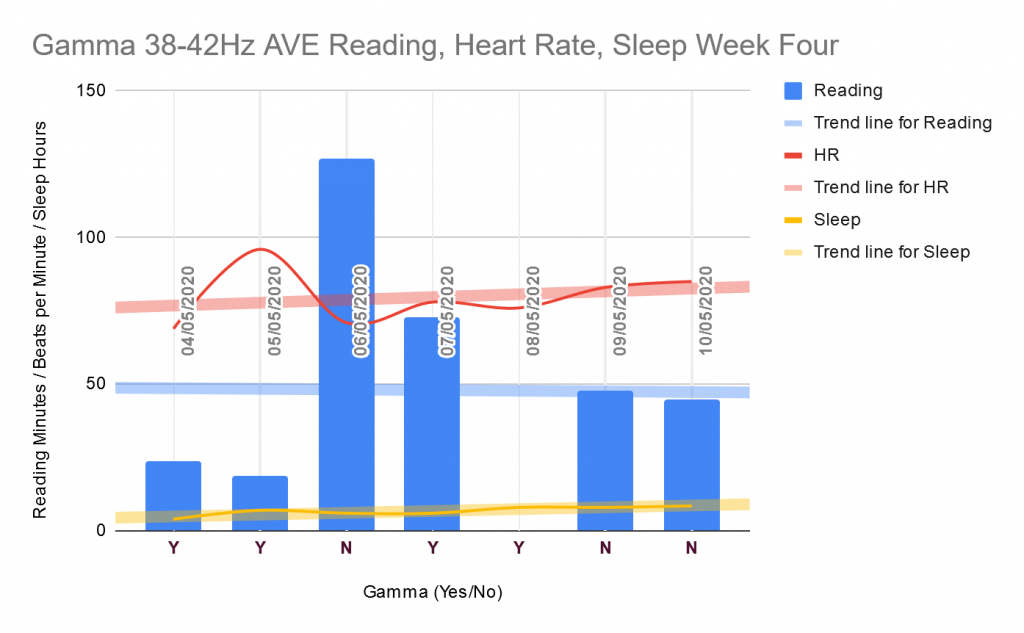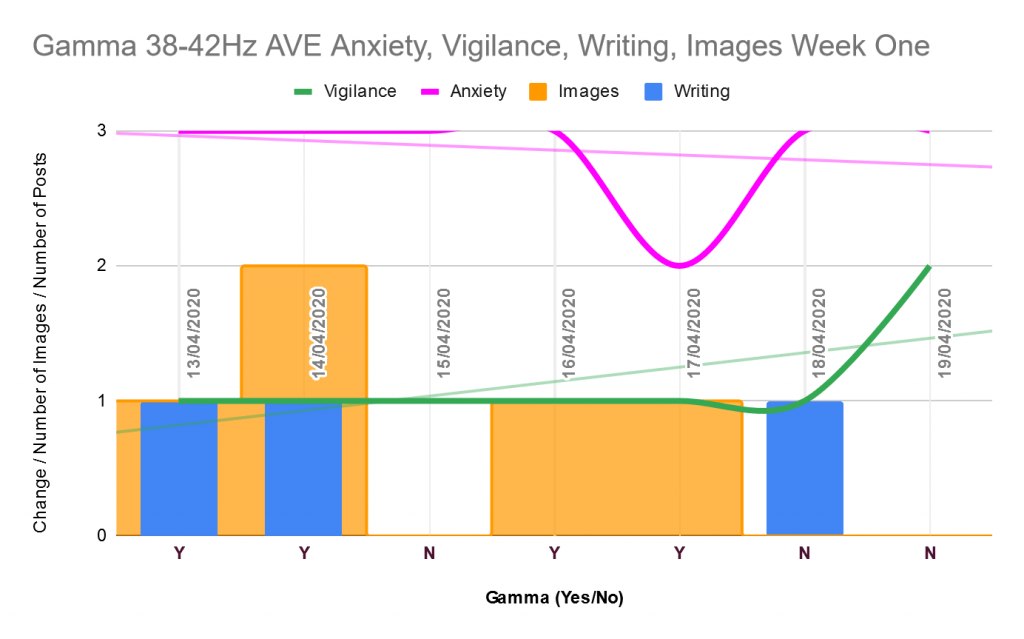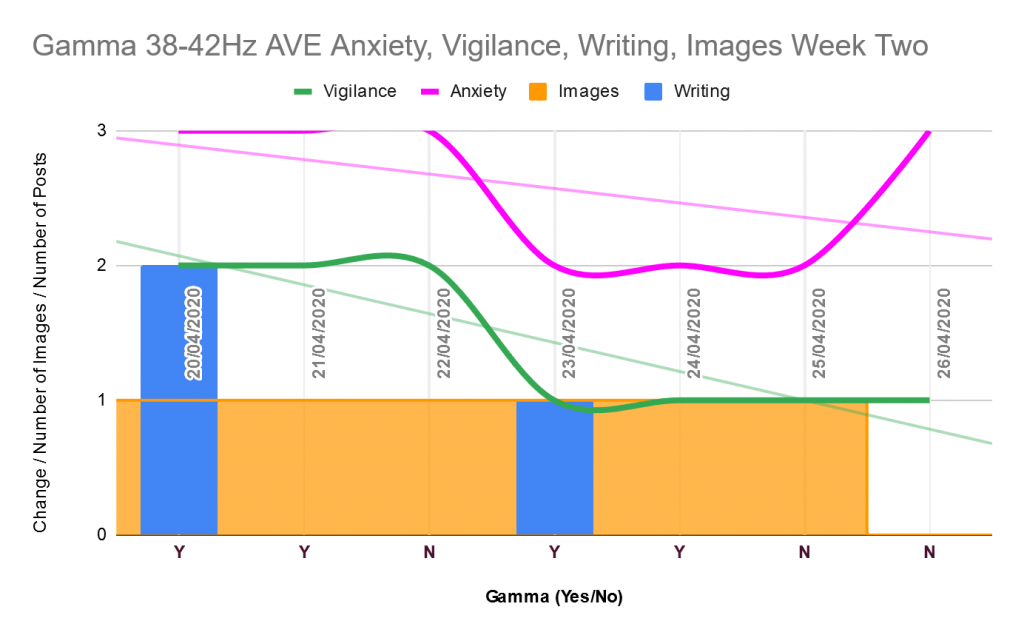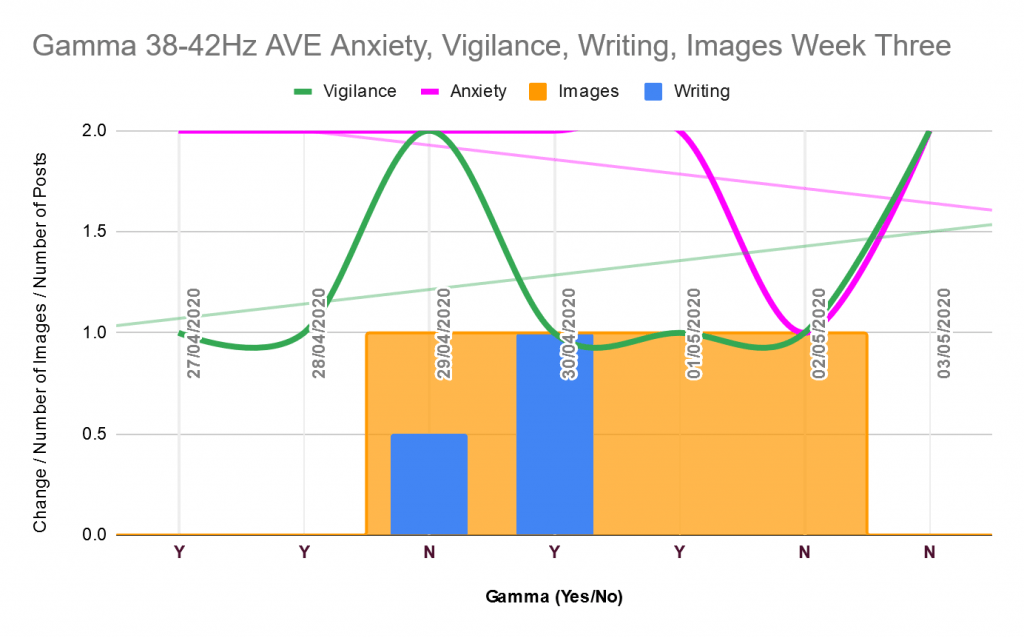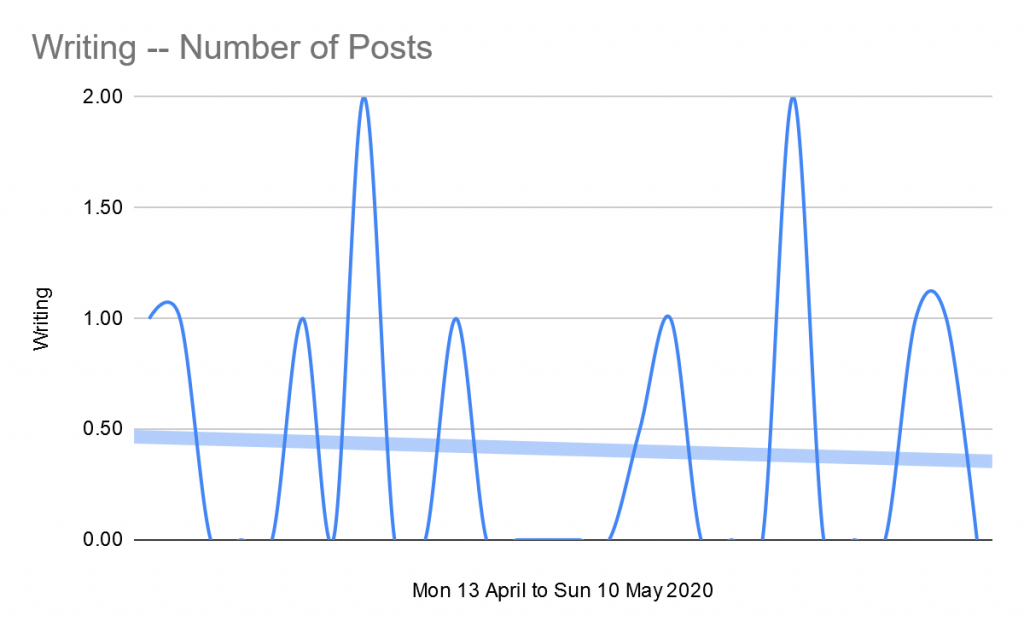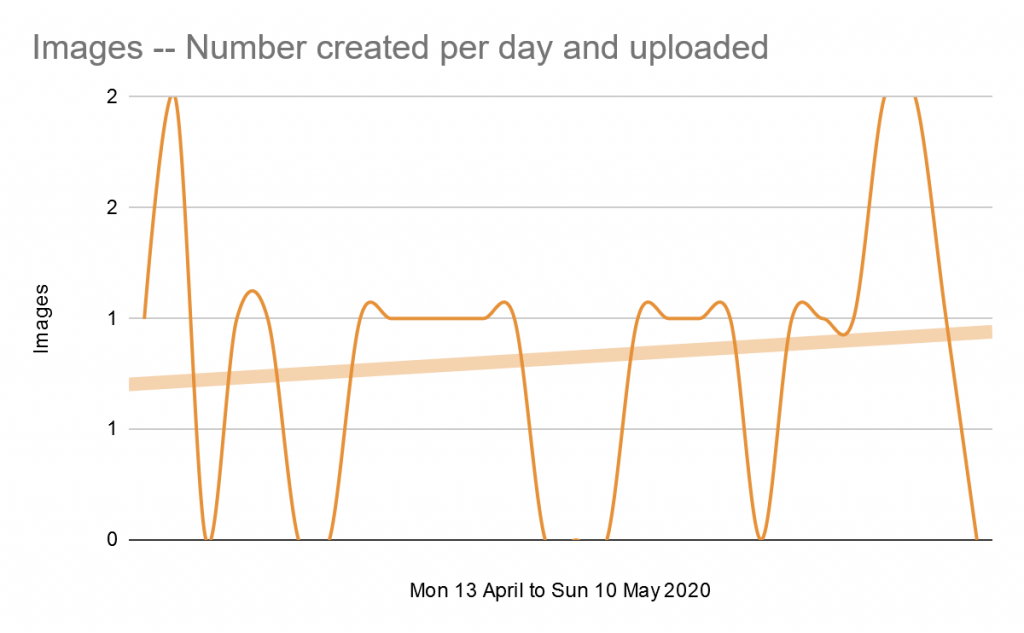On 13 April 2020, I began a single subject study into audiovisual entrainment of gamma brainwaves at 38 to 42Hz. The ideal gamma brainwave frequency one wants is 40Hz. I finished it yesterday, 10 May 2020. Today, I present the results of four weeks of this study.
Results
I measured the effect of gamma 38 to 42Hz audiovisual entrainment on three neurophysiological states and three productivity states: Anxiety, vigilance, sleep; reading, writing, and image creation. I also monitored morning heart rate, which for me reflects a specific type of stress or I’m battling an infection. I didn’t measure fatigue because I work up to the level of my fatigue, and quite frankly, I’m sick of being asked, “on a scale from one to ten, what would you say your fatigue is at?” Let’s just say 11 all the time, with spikes up to 1000, and on a very good day, drops down to maybe 7.
Of these measures, heart rate, sleep hours, numbers of posts and images uploaded, and reading minutes, are the closest to objective measurements. Because of the exigencies of COVID-19, I could not have my brainwaves monitored or checked weekly, which is the most objective way to look at anxiety, stress, and vigilance.
I used Google Sheets to track and chart my progress.
Some notes: week three began with fatigue so extreme, my neurodoc became concerned and reviewed all possible sources. We have not pinned down the reasons, and although it has let up some, it continues to plague me. One possibility: the gamma brainwave audiovisual entrainment is pushing my brain towards healthier brainwave activity and the change is consuming more brain resources. Unfortunately, the fatigue affects negatively stress, anxiety, and productivity. The more fatigued, the higher my heart rate, the higher my anxiety, and the lower my productivity. With that skewing of results in mind, here they are:
- My anxiety trended down.
- My vigilance trended down.
- My sleep, in number of hours, trended up, though it really only began to in week four.
- My reading, in number of minutes, trended up.
- My writing, in number of posts per day counted across my website, my political blog, and Psychology Today, trended down.
- My image creation, in number created per day and uploaded to Flickr, trended up.
The results are shown in the charts below. The top row shows changes in reading, heart rate (HR), and sleep, week one to week four, left to right. The second row shows changes in anxiety, vigilance, writing, image creation, week one to week four, left to right. The third row the big picture over the four weeks. The fourth row isolates out sleep, writing, and image creation so as to see their trend lines better.
Discussion
Overall, this experiment was a success. It replaced my weekly brain biofeedback fairly well and improved my productivity significantly, while reducing my anxiety and vigilance to manageable levels.
My initial experimenting with Mind Alive DAVID Delight Pro’s three gamma audiovisual entrainment sessions reduced significantly the extreme vigilance COVID-19 instigated in me, and using 38 to 42Hz session four times a week gradually kept the improvement sticking during days I didn’t use the gamma sessions.
If I’m able to keep going with either 38 to 42Hz or SMR/gamma, looking at the trend, I suspect the same will happen with anxiety, that the reduction will hold during days I don’t use gamma brainwave audiovisual entrainment.
I counted any post I wrote as one post, whether it took research and multiple drafts or was a quick 15-minute one. Perhaps measuring writing in minutes as I did reading, would be a more accurate measurement. But I was not up to the task of timing my writing. Whereas I read in one or maybe two bursts, I write multiple times over the day to create one post. That makes it harder to track time. Even though the trend line for writing was down, you can see that fatigue in week three affected it the most, and in week four when my fatigue began to ease a little, writing increased.
Being able to read consistently is a major goal of mine, which I track through Goodreads and its Reading Challenge. Gamma made that possible. Fatigue got me off track a little but not as much as it usually does.
Returning to my photography and being able to create images most days of the week was an unexpected bonus. I theorize this happened mostly because gamma turned my initiation button on. I was tracking several other measures on Google Sheets that I didn’t post, one of which was, was the initiation Go button on or off? (See my book Concussion Is Brain Injury: Treating the Neurons and Me for a discussion of the initiation Go button.) Whereas in week one, it would be off during non-gamma days, by week two, it remained on. This could also be another source of the extreme fatigue that hit me in week three: being able to initiate ideas or ToDos meant greater energy consumption beyond my norm. Normally, fatigue could keep that button off. Learning to balance initiation with fatigue so that the former doesn’t increase the latter will be something I’ll have to do.
Another thing I noted was that I had greater patience in writing and reading. I was better able to persist through the more difficult cognitive aspects of either or to work on the finer details that require more effort to stick it. Week three is when I became consistently patient.
Since fatigue is a big problem with brain injury, I depend on the energy neuroplastic treatments provide. Even though they may fatigue in the short term — minutes for audiovisual entrainment, hours for brain biofeedback — they almost always increase energy. The increase may last hours, but with consistent use and long-term improvement, baseline energy levels increase over the years. And so the energy pop from gamma entrainment became one key benefit. This pop occurred up to 20 minutes after the end of the gamma 38 to 42Hz session and a minimum of 10 minutes rest, usually up to 30 minutes. It’s like the brain needs to settle down after unaccustomed entrainment before it can work with this improved brainwave activity.
My eye surgery in 2016 changed my vision dramatically. Vision results from eye-brain interaction, to put it simplistically. Gamma brainwave biofeedback helped reinforce these improvements; audiovisual entrainment does the same thing I discovered. The effects from both don’t last, though they persist longer and longer, because, as my ophthalmologist noted, my brain will always fight to shut down the new vision. Perhaps more years of training the brain to use the new vision will stabilize it. It’s noteworthy that “Randolph Helfrich at the University of California, Berkeley, and his colleagues devised a way to enhance or reduce gamma oscillations of around 40 hertz using a non-invasive technique called transcranial alternating current stimulation (tACS). By tweaking these oscillations, they were able to influence whether a person perceived a video of moving dots as travelling vertically or horizontally.” (Nature, How flashing lights and pink noise might banish Alzheimer’s, improve memory and more, 28 Feb 2018) In other words, gamma improves perceptual acuity. (See my book for more discussion on how neuroplastic treatments affect perception and vision.)
My neurodoc provided feedback on my demeanour and affect. Overall, he noted reasonable to bright demeanour in response to the gamma sessions, although fatigue could overshadow these effects. This feedback reinforces my belief that future research on gamma brainwave entrainment or biofeedback ought to measure and monitor affect and alertness. I don’t think research into gamma should be confined to specific physical injuries or diseases, but should encompass psychiatric areas. Drugs are more and more falling out of favour as patients object to their plethora of debilitating side effects, as well as psychiatry’s unfortunate devolution into pill pushing. Already, clinics that use brain biofeedback are discovering that neuroplastic treatments enhance talk therapy, making it easier for people to verbalize difficult material. Perhaps expanding this into gamma frequencies could prove valuable. Why would people feel better with gamma training? I theorize the productivity increase, the improved sense of competence from greater functionality, and gamma as a foundational brainwave that lifts all other good brainwave activity, contribute to this emerging bright affect and alertness. The happy gamma effect is real and figuring out why it happens would make for an interesting investigation.
The effects of gamma brainwave entrainment began to diminish later and later after each session with each succeeding week. I know from experience with other brainwave frequencies that brain biofeedback leads to permanent change whereas audiovisual entrainment may or may not. Longitudinal studies on audiovisual entrainment alone, without the use of brain biofeedback, would definitively answer that question. However, gamma brainwave biofeedback doesn’t seem to have stuck to the same extent. It’s the only brainwave training that I’ve had to return to at the ADD Centre. I don’t know if this is because of the intense long-term stressors I’ve been subjected to or because my eye surgery resulted in the auditory and visual centres battling over the same piece of brain matter. Or because whole-brain diffuse axonal injury requires restoring gamma brainwaves as the last step in full restoration, and until such full recovery happens, the main effects I discussed in Chapter R of Concussion Is Brain Injury: Treating the Neurons and Me remain, but some of the more nuanced issues of fatigue, brightness, patience, initiation, anxiety, vigilance, and so on, require propping up.
In Chapter R, the research chapter on gamma brainwaves, I discussed two questions, one of which this study set out to investigate an answer to: could audiovisual entrainment get around the problem of reducing muscle tension to below 2uV and thus open up the possibility of gamma brainwave training to those with brain injury? I believe the answer is yes. The specific purpose of this study was:
“Without depending on reducing muscle tension, AVE can be shown to effect gamma enhancement in people with brain injury. This experiment is to determine if gamma AVE at 38 to 42Hz can decrease vigilance and anxiety while promoting cognitive activity and sleep.”
It did. And right at the very end, there may have been some positive changes in my ability to retrieve memories.
From my experimenting with the three different gamma sessions on the DAVID Delight Pro, I believe the brain responds better to a range than a single targetted frequency. We see this with brain biofeedback, where one seeks to enhance 39 to 42Hz, rather than the single point of 40Hz. It’s like a range allows the brain flexibility in achieving 40Hz rather than trying to shove it into that frequency and so leads to greater chance of success without prolonged headaches. Thus, future research ought to use the 38 to 42Hz session rather than the 40Hz session.
Considerations for Further Research
Expand my study to include a larger cohort. Researchers could look for people who have had diffuse axonal injury with prior brain training but without full recovery physically, psychologically, emotionally, cognitively, and socially.
Since my brain is well used to years of neuroplastic treatments or neuromodulation, one question that should be looked into is whether it’s better to train the brain first with standard single-electrode brain biofeedback in frequencies below gamma, LORETA, or with alpha and SMR/beta audiovisual entrainment before moving on to gamma, or to plunge in with gamma as the first kind of neuroplastic treatment offered? This line of investigation could also be used to determine if providing gamma audiovisual entrainment would potentiate either brain biofeedback or audiovisual entrainment of other frequencies. One group could receive gamma as their initial training, another as the final, and a third just before any other kind of brainwave frequency training as in provide 30-minute gamma audiovisual entrainment, 10-to-30 minute break, then provide brain biofeedback or audiovisual entrainment in the desired frequency range as determined by qEEG. Note that neuroplastic treatments are the definition of individualized medicine. The best results come from tailoring treatments to objective test results combined with other measures, as I outlined in my book.
I believe the main thrust of gamma brainwave research should be in the field of brain injury. We know brain injury leads to reduced gamma brainwaves, and apparently people with Alzheimer’s show the same. I realize researchers prefer to look in the area of Alzheimer’s, but we don’t as yet know or understand the development of this disease, whereas we understand the cause of brain injury and thus the reduction in gamma brainwave activity: an injury. This creates a simpler picture (though brain injury is far from simple). An understandable cause means by using neuroplastic treatments including targetting gamma brainwaves, you’re most likely to see real-world results in people with diffuse axonal injury and, along the way, you may discover clues to Alzheimer’s and how to use gamma brainwave training to treat it.
(This single subject study is an adjunct to Chapter R in response to COVID-19. For more information, references, etc., please see my book Concussion Is Brain Injury: Treating the Neurons and Me.)






